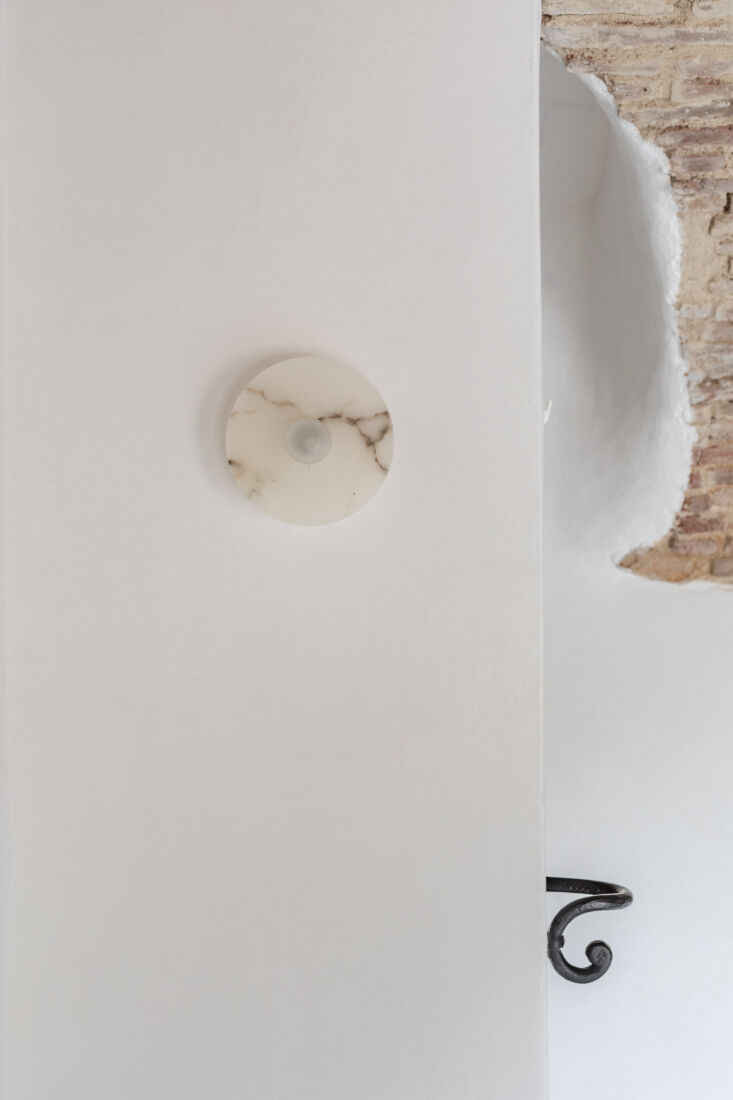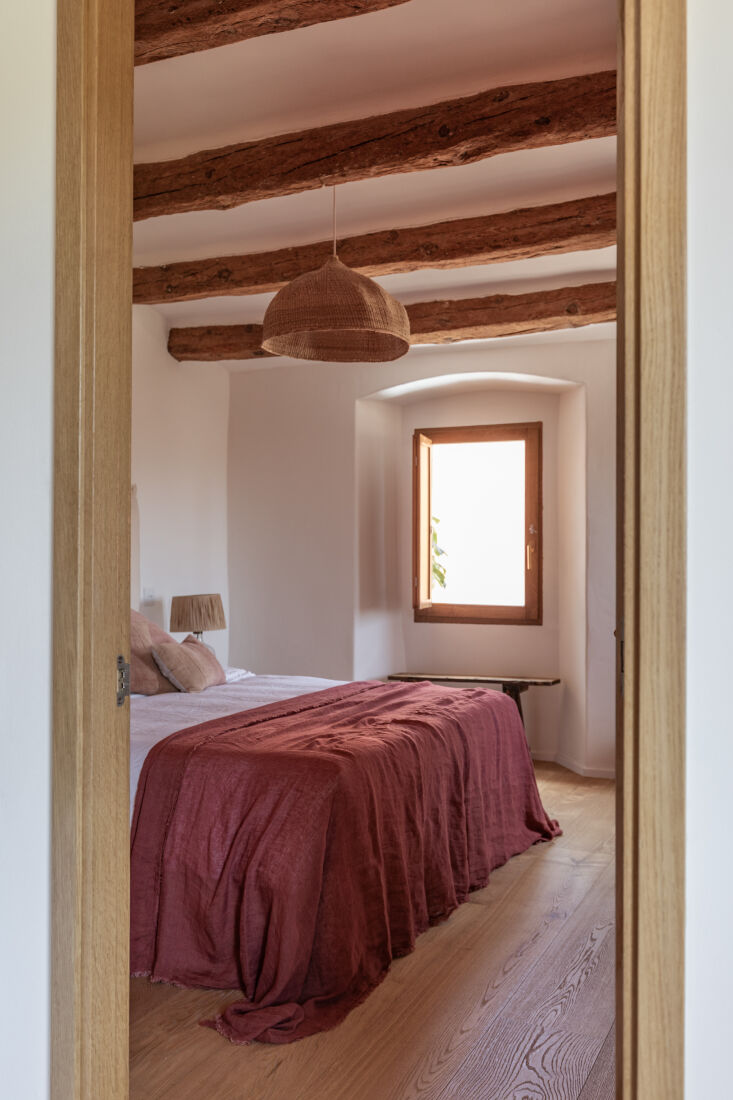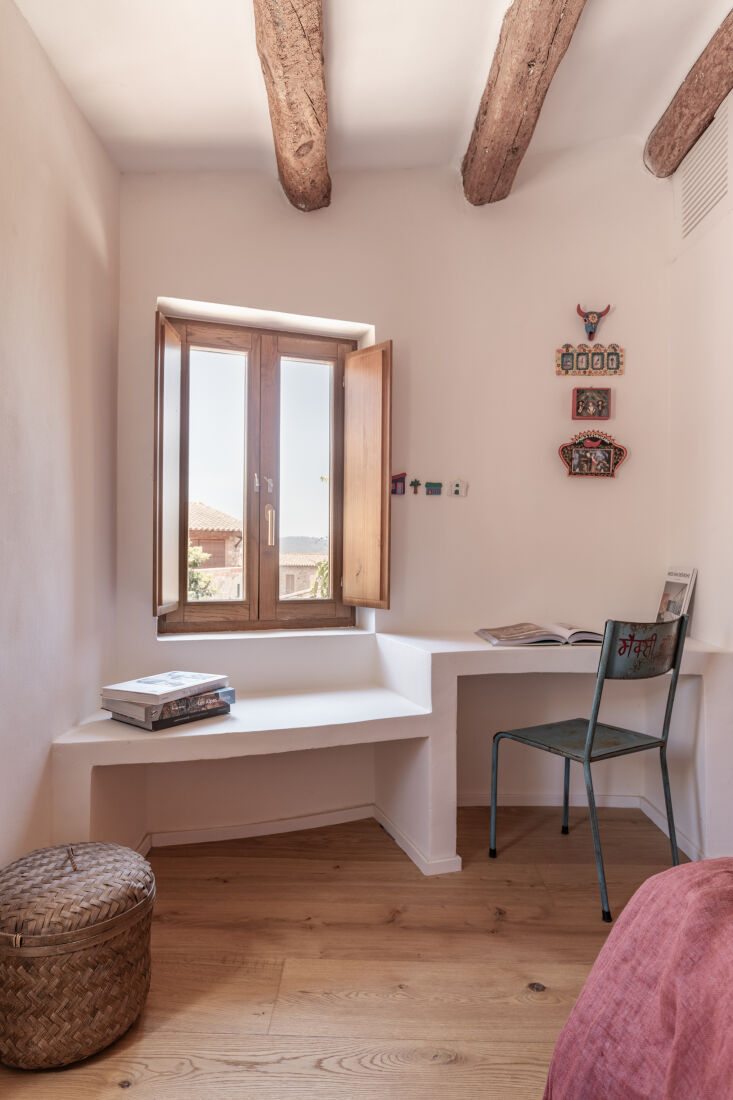When we first featured Espanyolet, the Mallorca-based project of Thomas Bossert and Melissa Rosenbauer, the year was 2016 and the duo had quit their jobs in New York, sold their belongings, and embarked on an Eat, Pray, Love-esque year of adventure in which they ended up studying, and falling in love with, natural pigments—and Spain.
A lot has changed since that first post (Antique Spanish Drap Cloth Made New: Espanyolet in Mallorca), including Espanyolet itself. “When we started with our textile products, color and texture were always extremely important to us,” Thomas wrote to us recently from Spain. “Soon we started experimenting with other surfaces that could represent the same color/texture philosophy. That’s when we started with lime walls, ceramic objects, and furniture. When we couldn’t do it ourselves we tried to find other makers and artisans that could collaborate with us. Our clients saw what we were experimenting with and soon asked us to help them with the design of entire rooms and later houses.”
Now the duo designs full-fledged interiors projects—and their own pigmented textiles and limewashes make appearances, too. “Our products are only available to our interior design clients,” Thomas adds. “It’s part of our special sauce.”
Have a look around one of Espanyolet’s recent projects: a historic Catalan farmhouse, redone. (Then scroll down for a look at the drastic Before shots.)
Photography by Pernilla Danielsson, courtesy of Espanyolet.
After
 Above: The house had suffered through several less-than-ideal renovations “in the 1960s, ’70s, or ’80s,” Thomas and Melissa surmise, “which left it feeling fragmented and not united. Weird steps up and weird steps down between rooms that should have flowed better.” Much of Espanyolet’s process involved stripping the farmhouse back to the original elements—including digging the floors down to “their dirt origins” and, after much thought, replacing them with microcement for visual ease.
Above: The house had suffered through several less-than-ideal renovations “in the 1960s, ’70s, or ’80s,” Thomas and Melissa surmise, “which left it feeling fragmented and not united. Weird steps up and weird steps down between rooms that should have flowed better.” Much of Espanyolet’s process involved stripping the farmhouse back to the original elements—including digging the floors down to “their dirt origins” and, after much thought, replacing them with microcement for visual ease. Above: “When we first saw the house, we loved all the original, traditional elements, like the vaulted brick ceilings, stone stairs, and stone frames of the doors,” Thomas writes. “We wanted to honor these while infusing a more modern and contemporary flair. That’s where the idea of microcement floors came from, as well as the stainless steel kitchen and the wooden floors upstairs.” The stainless steel kitchen (one of our trends for 2024) is by Santos.
Above: “When we first saw the house, we loved all the original, traditional elements, like the vaulted brick ceilings, stone stairs, and stone frames of the doors,” Thomas writes. “We wanted to honor these while infusing a more modern and contemporary flair. That’s where the idea of microcement floors came from, as well as the stainless steel kitchen and the wooden floors upstairs.” The stainless steel kitchen (one of our trends for 2024) is by Santos. Above: The original stone ceiling arches above the cookspace.
Above: The original stone ceiling arches above the cookspace. Above: Though it looks original, the duo built the built-in “sofa de obra” anew and layered it with “beautiful vintage linen, un-dyed.”
Above: Though it looks original, the duo built the built-in “sofa de obra” anew and layered it with “beautiful vintage linen, un-dyed.” Above: A pair of leather sling chairs, from Obsolete, in a sitting area.
Above: A pair of leather sling chairs, from Obsolete, in a sitting area. Above: Round jute rugs—found at a nearby shop—echo the house’s curves.
Above: Round jute rugs—found at a nearby shop—echo the house’s curves.
 Above: A built-in nook and original stone window at the top of the stairs.
Above: A built-in nook and original stone window at the top of the stairs.
 Above: One of four bedrooms, featuring an Espanyolet-made cloth headboard.
Above: One of four bedrooms, featuring an Espanyolet-made cloth headboard.
 Above: Espanyolet’s lime walls are a collaboration with local artisans. “We do not make the lime paste or paint ourself; there are amazing artisans on Mallorca who have been perfecting this art over hundreds of years,” writes Thomas. “All materials used are natural and from this island. The lime used has amazing antibacterial properties and will protect from mold. We then add our special technique while applying the paste or paint. We never just use one color, and a wall is really a big piece of art for us. Just one wall in a room will be enough to reflect color into the entire space.”
Above: Espanyolet’s lime walls are a collaboration with local artisans. “We do not make the lime paste or paint ourself; there are amazing artisans on Mallorca who have been perfecting this art over hundreds of years,” writes Thomas. “All materials used are natural and from this island. The lime used has amazing antibacterial properties and will protect from mold. We then add our special technique while applying the paste or paint. We never just use one color, and a wall is really a big piece of art for us. Just one wall in a room will be enough to reflect color into the entire space.”
 Above: The pink tiles are actually natural terra cotta from Todobarro; the vintage ship window was already in the house.
Above: The pink tiles are actually natural terra cotta from Todobarro; the vintage ship window was already in the house.
 Above: Original beams and raw linen coverlets in a twin bedroom.
Above: Original beams and raw linen coverlets in a twin bedroom.
 Above: Thomas and Melissa in the farmhouse.
Above: Thomas and Melissa in the farmhouse.
 Above: The view.
Above: The view.
Before
 Above: Before, with terra cotta floors and much clutter distracting from the vaulted ceilings.
Above: Before, with terra cotta floors and much clutter distracting from the vaulted ceilings.
 Above: Fairly unrecognizable. (For more Before photos, head to Espanyolet.)
Above: Fairly unrecognizable. (For more Before photos, head to Espanyolet.)
More favorites on Mallorca:
- Shed Chic: Architect Mariana de Delás Turns an Off-the-Grid Hut into a Dream Retreat
- Before & After: A Bright 17th-Century House Overlooking the Sea on Mallorca, for Two Young Architects
- A Ceramicist’s Intimate, Elegant Wedding on Mallorca (DIY Candleholders Included)
N.B.: This story originally ran on January 22, 2024 and has been updated.







